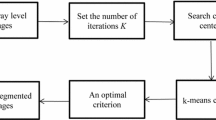Abstract
Clustering is an important approach in image segmentation. While various clustering algorithms have been proposed, the majority of them require one or more parameters as input, making them a little inflexible in practical applications. In order to solve the parameter dependent problem, in this paper we present a parameter-free clustering algorithm based on the dominant sets. We firstly study the influence of regularization parameters on the dominant sets clustering results. As a result, we select an appropriate regularization parameter to generate over-segmentation in clustering results. In the next step we merge clusters based on the relationship between intra-cluster and inter-cluster similarities. While being simple, our algorithm is shown to improve the clustering quality significantly in comparison with the dominant sets algorithm in data clustering and image segmentation experiments. It also performs comparably to or better than some other clustering algorithms with manually selected parameters input.
Access this chapter
Tax calculation will be finalised at checkout
Purchases are for personal use only
Similar content being viewed by others
References
Ester, M., Kriegel, H.P., Sander, J., Xu, X.W.: A density-based algorithm for discovering clusters in large spatial databases with noise. In: International Conference on Knowledge Discovery and Data Mining, pp. 226–231 (1996)
Agrawal, R., Gehrke, J., Gunopulos, D., Raghavan, P.: Automatic subspace clustering of high dimensional data. In: International Conference on Knowledge Discovery and Data Mining, pp. 517–521 (2005)
Shi, J., Malik, J.: Normalized cuts and image segmentation. IEEE Trans. Pattern Anal. Mach. Intell. 22, 167–172 (2000)
Brendan, J.F., Delbert, D.: Clustering by passing messages between data points. Science 315, 972–976 (2007)
Rodriguez, A., Laio, A.: Clustering by fast search and find of density peaks. Science 344, 1492–1496 (2014)
Zhu, X., Loy, C.C., Gong, S.: Constructing robust affinity graphs for spectral clustering. In: IEEE International Conference on Computer Vision and Pattern Recognition, pp. 1450–1457 (2014)
Gong, M., Liang, Y., Shi, J., Ma, W., Ma, J.: Fuzzy c-means clustering with local information and kernel metric for image segmentation. IEEE Trans. Image Process. 22, 573–584 (2013)
Fowlkes, C., Belongie, S., Fan, C., Malik, J.: Spectral grouping using the nystrom method. IEEE Trans. Pattern Anal. Mach. Intell. 26, 214–225 (2004)
Yan, D., Huang, L., Jordan, M.I.: Fast approximate spectral clustering. In: International Conference on Knowledge Discovery and Data Mining, pp. 907–916 (2009)
Niu, D., Dy, J.G., Jordan, M.I.: Dimensionality reduction for spectral clustering. In: International Conference on Artificial Intelligence and Statistics, pp. 552–560 (2011)
Fraley, C., Raftery, A.E.: How many clusters? Which clustering method? Answers via model-based cluster analysis. Comput. J. 41, 578–588 (1998)
Monti, S., Tamayo, P., Mesirov, J., Golub, T.: Consensus clustering: a resampling-based method for class discovery and visualization of gene expression microarray data. Mach. Learn. 52, 91–118 (2003)
Evanno, G., Regnaut, S., Goudet, J.: Detecting the number of clusters of individuals using the software structure: a simulation study. Mol. Ecol. 14, 2611–2620 (2005)
Dueck, D., Frey, B.J.: Non-metric affinity propagation for unsupervised image categorization. In: IEEE International Conference on Computer Vision, pp. 1–8 (2007)
Bansal, N., Blum, A., Chawla, S.: Correlation clustering. Mach. Learn. 56, 89–113 (2004)
Demaine, E.D., Emanuel, D., Fiat, A., Immorlica, N.: Correlation clustering in general weighted graphs. Theor. Comput. Sci. 361, 172–187 (2006)
Pavan, M., Pelillo, M.: Dominant sets and pairwise clustering. IEEE Trans. Pattern Anal. Mach. Intell. 29, 167–172 (2007)
Torsello, A., Bulo, S.R., Pelillo, M.: Grouping with asymmetric affinities: a game-theoretic perspective. In: IEEE International Conference on Computer Vision and Pattern Recognition, vol. 1, pp. 292–299 (2006)
Yang, X.W., Liu, H.R., Laecki, L.J.: Contour-based object detection as dominant set computation. Pattern Recogn. 45, 1927–1936 (2012)
Hou, J., Pelillo, M.: A simple feature combination method based on dominant sets. Pattern Recogn. 46, 3129–3139 (2013)
Hamid, R., Maddi, S., Johnson, A.Y., Bobick, A.F., Essa, I.A., Isbell, C.: A novel sequence representation for unsupervised analysis of human activities. Artif. Intell. 173, 1221–1244 (2009)
Pavan, M., Pelillo, M.: A graph-theoretic approach to clustering and segmentation. In: IEEE International Conference on Computer Vision and Pattern Recognition, pp. 145–152 (2003)
Gionis, A., Mannila, H., Tsaparas, P.: Clustering aggregation. ACM Trans. Knowl. Discov. Data 1, 1–30 (2007)
Veenman, C.J., Reinders, M., Backer, E.: A maximum variance cluster algorithm. IEEE Trans. Pattern Anal. Mach. Intell. 24, 1273–1280 (2002)
Jain, A.K., Law, M.H.C.: Data clustering: a user’s dilemma. In: Pal, S.K., Bandyopadhyay, S., Biswas, S. (eds.) PReMI 2005. LNCS, vol. 3776, pp. 1–10. Springer, Heidelberg (2005)
Fu, L., Medico, E.: Flame, a novel fuzzy clustering method for the analysis of dna microarray data. BMC Bioinform. 8, 1–17 (2007)
Daszykowski, M., Walczak, B., Massart, D.L.: Looking for natural patterns in data: part 1. density-based approach. Chemometr. Intell. Lab. Syst. 56, 83–92 (2001)
Acknowledgments
This work is supported in part by the National Natural Science Foundation of China under Grant No. 61473045 and No. 41371425, and by the Program for Liaoning Innovative Research Team in University (LT2013023).
Author information
Authors and Affiliations
Corresponding author
Editor information
Editors and Affiliations
Rights and permissions
Copyright information
© 2016 Springer International Publishing Switzerland
About this paper
Cite this paper
Hou, J., Sha, C., Cui, H., Chi, L. (2016). Dominant Set Based Data Clustering and Image Segmentation. In: Tian, Q., Sebe, N., Qi, GJ., Huet, B., Hong, R., Liu, X. (eds) MultiMedia Modeling. MMM 2016. Lecture Notes in Computer Science(), vol 9516. Springer, Cham. https://doi.org/10.1007/978-3-319-27671-7_36
Download citation
DOI: https://doi.org/10.1007/978-3-319-27671-7_36
Published:
Publisher Name: Springer, Cham
Print ISBN: 978-3-319-27670-0
Online ISBN: 978-3-319-27671-7
eBook Packages: Computer ScienceComputer Science (R0)




